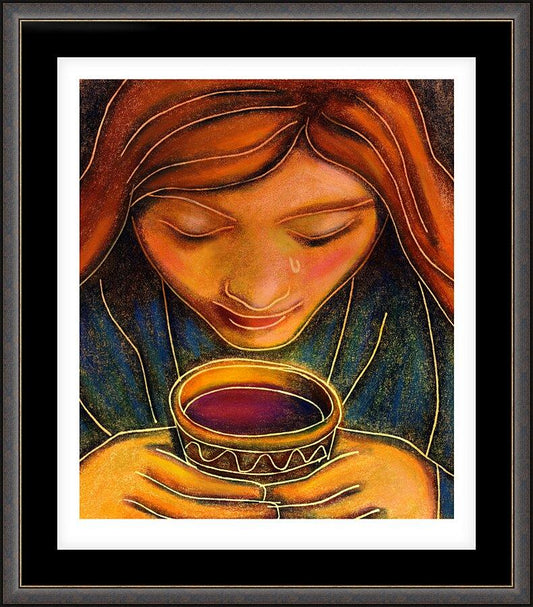In Roman Catholicism, Eastern Orthodoxy, Oriental Orthodoxy, Anglicanism, Lutheranism and some other Christian denominations, a chalice is a standing cup used to hold sacramental wine during the Eucharist (also called the Lord's Supper or Holy Communion). Chalices are often made of precious metal, and they are sometimes richly enameled and jeweled. The gold goblet was symbolic for family and tradition.
The ancient Roman calix was a drinking vessel consisting of a bowl fixed atop a stand, and was in common use at banquets. Chalices have been used since the early church. Because of Jesus' command to his disciples to "Do this in remembrance of me." (Luke 22:19), and Paul's account of the Eucharistic rite in 1 Corinthians 11:24-25, the celebration of the Eucharist became central to Christian liturgy. Naturally, the vessels used in this important act of worship were highly decorated and treated with great respect. A number of early examples of chalices have a large bowl and two handles. Over time, the size of the bowl diminished and the base became larger for better stability. Over time, official church regulations dictated the construction, blessing, and treatment of chalices. Some religious traditions still require that the chalice, at least on the inside of the cup, be made of gold.
In Western Christianity, chalices will often have a pommel or node where the stem meets the cup to make the elevation easier. In Roman Catholicism, chalices tend to be tulip-shaped, and the cups are quite narrow. Roman Catholic priests will often receive chalices from members of their families when first ordained.
In Eastern Christianity (Oriental Orthodox, Eastern Orthodox and Eastern Catholic churches), chalices will often have icons enameled or engraved on them, as well as a cross. In Orthodoxy and Eastern Catholicism, all communicants receive both the Body of Christ and the Blood of Christ. To accomplish this, a portion of the Lamb (Host) is placed in the chalice, and then the faithful receive Communion on a spoon. For this reason, eastern chalices tend to have larger, rounded cups. In the Russian Orthodox Church, the faithful will often kiss the "foot" (base) of the chalice after receiving Holy Communion. In other traditions, they will kiss the cup. Although Orthodox monks are not permitted to hold personal possessions, the canons permit a hieromonk (i.e., a monk who has been ordained to the priesthood) to keep a chalice and other vessels necessary to celebrate the Divine Liturgy.
In the early and medieval church, when a deacon was ordained, he would be handed a chalice during the service as a sign of his ministry. Early written accounts of the ordination of deaconesses also reflect this practice. In the West the deacon carries the chalice to the altar at the offertory; in the East, the priest carries the chalice and the deacon carries the paten (diskos). Only wine, water and a portion of the Host are permitted to be placed in the chalice, and it may not be used for any profane purpose.
The chalice is considered to be one of the most sacred vessels in Christian liturgical worship, and it is often blessed before use. In the Roman Catholic Church, and some Anglo-Catholic churches, it was the custom for a chalice to be consecrated by being anointed with chrism, and this consecration could only be performed by a bishop or abbot (only for use within his own monastery). Among the Eastern Churches there are varying practices regarding blessing. In some traditions the very act of celebrating the Sacred Mysteries (Sacrament) is the only blessing necessary; in others, there is a special rite of blessing. In some Eastern traditions this blessing may be done only by a bishop, in some it may be done by a priest. In any case, in both the East and the West, once a chalice has been blessed, it may only be touched by an ordained member of the higher clergy (bishop, priest or deacon). In the Russian Orthodox Church a subdeacon is permitted to touch the holy vessels, but only if they are wrapped in cloth.




















